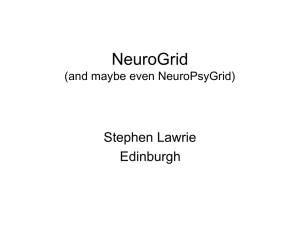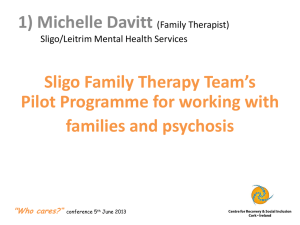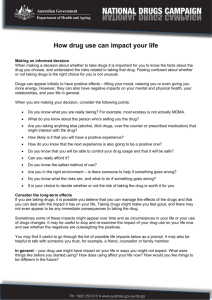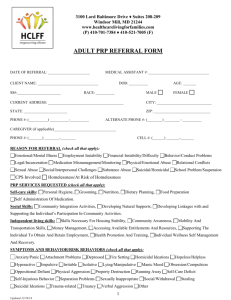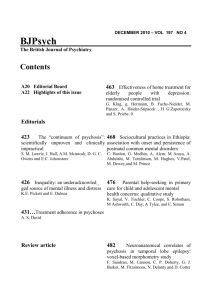NeuroGrid & PsyGrid Stephen Lawrie & Alan Williams Edinburgh Manchester
advertisement
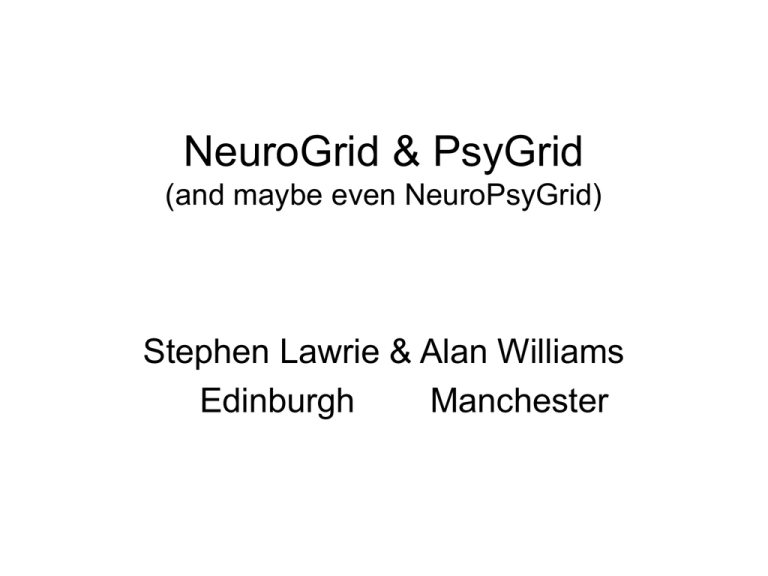
NeuroGrid & PsyGrid (and maybe even NeuroPsyGrid) Stephen Lawrie & Alan Williams Edinburgh Manchester A collaboration between clinical, imaging and e-scientists to create a Grid-based network of neuroimaging centres and a neuroimaging tool-kit, focused on three clinical exemplars: dementia, stroke and psychosis. Sharing data, experience and expertise will facilitate the archiving, curation, retrieval and analysis of imaging data from multiple sites & enable large clinical studies. The main issues in (UK) clinical brain imaging studies • - Potential: demonstrate effects of risk factors, including genes; early diagnosis; treatment response / prognosis prediction; treatment effect monitoring; biomarker for novel drug development • Concerns: - lack of standardisation across scanners and even in basic approach to e.g. ‘connectivity’; - lack of normative data reference points for relevant age ranges; - safe data storage; - expense; - constantly developing technology Neurogrid – psychosis exemplar 1. 2. 3. Database and ontology, building on EHRS data set (0.5WTE) Scanner harmonisation issues, focussing on EHRS use of two machines (1WTE) Combined analysis of psychosis data sets from Oxford & Edinburgh, focussing on sex / assymmetry (1 WTE) Registration and Partial Volume Metric for Multi-Center sMRI Scanner Harmonization Moorhead TWJ, Job DE, Gountouna V-E, Johnstone EC, Lawrie SM. HBM2005. NeuroImage 2005 Signal-to-Noise (SNR) and Contrast-to-Noise (CNR) metrics in longitudinal and multicenter MRI studies Gountouna VE, Moorhead TWJ, Job DE, Johnstone EC, Lawrie SM. HBM2005 NeuroImage 2005 Entropy as a measure of scanner and sequences change. Dominic E. Job, T. William J. Moorhead, Eve C. Johnstone, Stephen M. Lawrie. NeuroImage 2006 Volume 31, Supplement 1 Annual Meeting Human Brain Mapping, June 11-15 Florence Italy Test-retest reliability of the Hayling sentence completion task: assessment for multicenter fMRI using voxel-wise Intraclass Correlation Coefficients (ICCs). Viktoria-Eleni Gountouna, Heather Whalley, T.William Moorhead, Dominic Job, David McGonigle, Eve Johnstone, Stephen Lawrie. HBM2006 NeuroImage 2006 Volume 31, Edinburgh High Risk Study •A prospective study of ~200 subjects at high risk (HR) of Schizophrenia for genetic reasons i.e. initially healthy subjects aged 16-25 who had two or more close relatives with schizophrenia. Compared to first-episode cases and healthy controls on... • - Baseline measures genetic liability dermatoglyphics obstetric complications minor physical anomalies / neurological ‘soft signs’ CBCL SIS RISC Also took blood for genes at the end of the study • - Repeated measures substance use life events neuropsychology structural MRI functional MRI PSE PANSS Edinburgh High Risk Study (EHRS) Main Results 1995-2004 Isolated and/or transient symptoms very common Baseline risk of psychosis 20 / 162 (~12.5%) Risk in HR+ i.e. those with symptoms 18 / 80 (25%) Most measures differed significantly between those at high risk and controls, typically with the sub-group pattern: Con </> HR- </> HR+ <</>> HRill Within high risk subjects, however, only AVLT, CBCL, RISC/SIS and some imaging indices predicted schizophrenia (Johnstone et al 2005 Br J Psych) Neuro-psychology: NART IQ, WAISR & VRs, RBMT story & especially AVLT 1-5 total score EHRS Baseline predictors 10 11 No. items recalled 9 8 7 6 FES HR CON 5 4 3 2 1 0 AHC - L AHC - R 3V Thal - L Thal - R Neuro-anatomy: AMYG-HIPP vol & Gyrification Index R PFC 10 9 8 7 CONTROL HR- HR+ ILL fMRI – HSCT (parametric contrast): AHC/STG * * * 4 2 3 a 1 4 * * * 1 3 b 2 4 2 1 d c 3 a.) R ahc/stg; b.) R lingual gyrus; c.) L ahc/stg; d.) L cerebellum * 4 3 1 2 * EHRS changes towards psychosis Cannabis use and major life events are associated with psychotic symptoms and (weakly) with psychosis 2-4 yrs later. 0-2 yrs pre-diagnosis, anxiety/depression fall, typical psychotic symptoms supervene and GM density falls. But, no apparent changes in neuropsychological test scores over this time. Mean scores on the six PSE principal components on three occasions of 8 HR subjects who fell ill (relative to NP chronics) depression 1.5 1 hallucinations and control delusions 0.5 0 -0.5 -1 -1.5 -2 -2.5 On entry 2nd time on falling ill mania oddness anxiety GM density Reduces In Right Uncus, Fusiform & Cerebellum 2.5 yrs on avge before Dx A health informatics project which builds on the DoH funded UK MHRN. Psygrid aims to develop the MHRN into a functioning “e-community” and build a secure electronic database to hold anonymised clinical data about people presenting to NHS services with first episode psychosis. Towards multi-centre clinical, genetic and brain imaging studies of people at high risk of psychosis: MRC Collaboration grant application NeuroPsyGrid: towards an ontology and multi-centre brain imaging in early psychosis Neuro/PsyGrid and BIRN • Shared interests in scanner (clinical and genetic) harmonisation and shared database, metadata and ontology for psychosis • During discussions about NPG we thought of looking at: - a collaborative ontology; - variations across sites in clinical and biological data acquisition; - using BIRN Bio-Mediator; - 4D spatio-temporal analyses of imaging (fMRI) and genetic data; - joint work on NeuroFMA; - a requirements analysis for NPG-BIRN harmonisation. Concluding remarks If brain imaging is to impact on clinical practice in psychiatry, as we know it could, we urgently require: - Multi-centre clinical studies of people in early stages of major psychiatric disorders - Standardisation of scanners and imaging acquisition and processing techniques across mental health research networks - Studies of normal neuro-development across age ranges of relevance to (adult) psychiatric disorders These would benefit, possibly even depend upon, on escience approaches to collecting, storing and accessing data.
